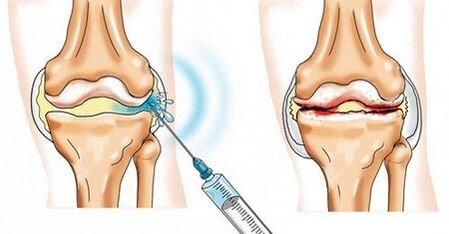
This is about such an unpleasant disease of the muscle bone system as the arthrosis of the knee joint.The article will find out what disease, why it occurs, the main symptoms of knee arthrosis, and how to treat this misleading disease.
The arthrosis of the knee joint (another name - gonarthrosis) is a chronic disease of the knee joint, in which the arthritis of the articular cartilage, followed by deformation of the joint and limiting motor activity.
Gonarthrosis is the most common type of arthrosis.The disease is most often diagnosed with people 40 years of age or older.In the older age group, knee arthrosis is more common in women, and the disease is more often diagnosed in men in younger patients.The cases are approx.In 7%, the disease leads to disability.
Reasons
The main causes of the development of the disease are as follows:
- Violation of metabolism in the body;
- overweight leading to an increase in knee joints;
- increased fragility of capillaries, various circulatory disorders;
- Knee joint injuries (cracks, fractures, meniscus fractures, ligaments);
- Some endocrine diseases;
- inflammatory arthritis (arthritis, rheumatism);
- old injuries that have been incorrectly cured;
- Traumatic sports classes on knee (heavy athletics, bodybuilding, football, gymnastics, tennis, athletics);
- hereditary predisposition;
- Congenital disorders of the structure of the knee joint.
Arthritis
The following types of arthrosis are distinguished by the origin:
- primary- most often occur during the elderly, patients with vulnerable patients are obesity;
- secondary- It develops after injuries to knee or infectious diseases, which have been incorrectly cured.
According to localization of the pathological process, the following types of arthrosis of the knee are distinguished:
- Left side- affects the left knee joint, which is most often observed in obesity athletes and with the middle share;
- Better -out- affects the right knee joint, more often in athletes and people whose work has increased dynamic and static loads on the right foot;
- bilateral- The most severe type of arthrosis of the knee joint, which can lead to disability, is most often found in older people.
Symptoms
The main clinical symptoms of the disease are as follows:
- Knee pain - at first, pain is increased physical effort for joints, movement, running, long walking and relaxation as the disease develops and patients occur when they try to move after a long rest period, the person with the knee arthrosis becomes permanent over time;
- Morning stiffness in the knee joint - it takes about half an hour and the duration may increase over time;
- Crunch in the knee while moving;
- With the development of the inflammatory process, patients complain of a feeling of difficulty in the knee, the joint is slightly swollen and increased;
- The shape of the joint is gradually changing, with deformation;
- With the further development of the disease, the lameness appears, the mobility of the knee joint is limited, the patient cannot completely press the sore leg;
- The atrophy of the femur muscles gradually develops, weak and acne, and a decrease in volume.
Treatment
When the first unpleasant symptoms appear, you should consult a doctor immediately and attend examination.Timely treatment increases the chances of healing and improves prognosis.Self -healing is unacceptable and can lead to many complications to disability!
Treatment of knee arthrosis includes the following stages.
Non -drug therapy
- The sore joint must ensure relaxation so that crutches or canes are used to unload it;
- ultraviolet irradiation, heat - to remove pain;
- Wearing special orthopedic shoes, knee pads, special soles;
- Massage, exercise therapy, physiotherapy are prescribed after stopping the acute stage of the disease.
Medication

- Reception of NSAIDs (tablets) and external (gels, ointments) - to relieve the inflammation and pain of the knee;
- Injections of special drugs are carried out in the joint cavity in the absence of NSAIDs;
- Slow system systems - normalization of metabolic processes in cartilage tissue;
- Tools for repairing blood circulation - contribute to normalization of blood circulation in the abnormal focus and improve drugs into the harmful zone.
Surgical intervention
This is visible with a complete loss of joint function and includes the prosthesis of the knee joint.
Health to you and your loved ones!























